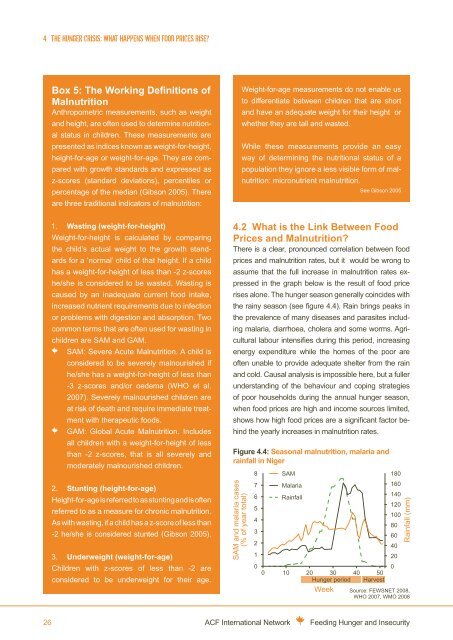Feeding hunger and insecurity
Feeding hunger and insecurity
Feeding hunger and insecurity
- No tags were found...
Create successful ePaper yourself
Turn your PDF publications into a flip-book with our unique Google optimized e-Paper software.
4. the <strong>hunger</strong> crisis: what happens when food prices rise?Box 5: The Working Definitions ofMalnutritionAnthropometric measurements, such as weight<strong>and</strong> height, are often used to determine nutritionalstatus in children. These measurements arepresented as indices known as weight-for-height,height-for-age or weight-for-age. They are comparedwith growth st<strong>and</strong>ards <strong>and</strong> expressed asz-scores (st<strong>and</strong>ard deviations), percentiles orpercentage of the median (Gibson 2005). Thereare three traditional indicators of malnutrition:Wasting (weight-for-height)Weight-for-height is calculated by comparingthe child’s actual weight to the growth st<strong>and</strong>ardsfor a ‘normal’ child of that height. If a childhas a weight-for-height of less than -2 z-scoreshe/she is considered to be wasted. Wasting iscaused by an inadequate current food intake,increased nutrient requirements due to infectionor problems with digestion <strong>and</strong> absorption. Twocommon terms that are often used for wasting inchildren are SAM <strong>and</strong> GAM.SAM: Severe Acute Malnutrition. A child isconsidered to be severely malnourished ifhe/she has a weight-for-height of less than-3 z-scores <strong>and</strong>/or oedema (WHO et al.2007). Severely malnourished children areat risk of death <strong>and</strong> require immediate treatmentwith therapeutic foods.GAM: Global Acute Malnutrition. Includesall children with a weight-for-height of lessthan -2 z-scores, that is all severely <strong>and</strong>moderately malnourished children.Stunting (height-for-age)Height-for-age is referred to as stunting <strong>and</strong> is oftenreferred to as a measure for chronic malnutrition.As with wasting, if a child has a z-score of less than-2 he/she is considered stunted (Gibson 2005).Underweight (weight-for-age)Children with z-scores of less than -2 areconsidered to be underweight for their age.Weight-for-age measurements do not enable usto differentiate between children that are short<strong>and</strong> have an adequate weight for their height orwhether they are tall <strong>and</strong> wasted.While these measurements provide an easyway of determining the nutritional status of apopulation they ignore a less visible form of malnutrition:micronutrient malnutrition.4.2 What is the Link Between FoodPrices <strong>and</strong> Malnutrition?There is a clear, pronounced correlation between foodprices <strong>and</strong> malnutrition rates, but it would be wrong toassume that the full increase in malnutrition rates expressedin the graph below is the result of food pricerises alone. The <strong>hunger</strong> season generally coincides withthe rainy season (see figure 4.4). Rain brings peaks inthe prevalence of many diseases <strong>and</strong> parasites includingmalaria, diarrhoea, cholera <strong>and</strong> some worms. Agriculturallabour intensifies during this period, increasingenergy expenditure while the homes of the poor areoften unable to provide adequate shelter from the rain<strong>and</strong> cold. Causal analysis is impossible here, but a fullerunderst<strong>and</strong>ing of the behaviour <strong>and</strong> coping strategiesof poor households during the annual <strong>hunger</strong> season,when food prices are high <strong>and</strong> income sources limited,shows how high food prices are a significant factor behindthe yearly increases in malnutrition rates.Figure 4.4: Seasonal malnutrition, malaria <strong>and</strong>rainfall in NigerSAM <strong>and</strong> malaria cases(% of year total)8765432100SAMMalariaRainfallSee Gibson 200518016014012010080604020Rainfall (mm)010 20 30 40 50Hunger period HarvestWeek Source: FEWSNET 2008,WHO 2007, WMO 200826ACF International Network<strong>Feeding</strong> Hunger <strong>and</strong> Insecurity

















